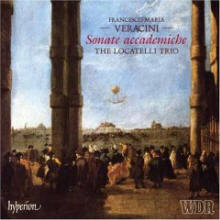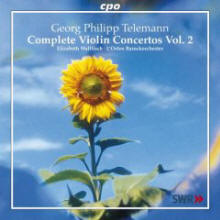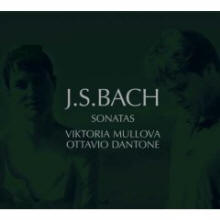|
You are reading the older HTML site Positive Feedback ISSUE july/august 2007
Notes of an Amateur - August, 2007, Part 1
Veracini, Sonate Accademiche, Opus 2. The Locatelli Trio: Elizabeth Wallfisch, violin; Richard Tunnicliffe, cello; Paul Nicholson, harpsichord & organ. Hyperion CDS 44241/3. (3 discs) One of the qualities we fans of early music violinist Elizabeth Wallfisch like best in her playing is bold and masterful bowing, which literally wrings the music out of her instrument. Lord help you if you have a CD player that can't handle the treble range with aplomb! But if your player is respectably well behaved, you will hear passion from baroque music you may not have known is there. Wallfisch is The Locatelli Trio. Richard Tunnicliffe in clearly an able cellist and Paul Nicholson a well-known and accomplished keyboard player. But their roles here are primarily to let Veracini do his thing through the medium of Elizabeth Wallfisch. This three-CD set is a re-release of performances made fourteen year ago, brought back into the catalog by some wise fool who is counting on the musical taste of this new century to welcome them back and justify the expense of the reissue. It was a great artistic decision and I am grateful to him or her, whoever he or she may be, and will try to do the project justice here. Veracini is among those Italian baroque composers who lurk behind Vivaldi in the today's musical consciousness, just as Telemann lurks behind Bach and Handel. (More about him below.) Together with Corelli (who admittedly is better known than the others), Tartini, Locatelli, Albinoni and even the Scarlattis—father and son, Veracini and his contemporaries composed a body of music that was critical in bringing about the flowering of German and English baroque music of the same and following generations. Handel began his composing career in Italy and Bach's Brandenbergs would be unthinkable without the Italian examples that preceded them. Even French baroque music was influenced by the Italians, primarily in reaction to it! In only remembering and valuing the major figures, which we tend to do in all of the arts, we lose a great deal, some of which you will hear recorded here. Just as we no longer read the plays of Ben Jonson, John Webster, George Chapman, and even Christopher Marlowe but stay with Shakespeare, thereby losing out not only on much good literature but also a real sense of exactly what Shakespeare was great at, we lose out in not spending some time with, well Veracini. There are wonderful things in Veracini that you will not find in Vivaldi—or in Bach and Handel either. This is wonderfully lusty, celestial music, and it is thanks to Wallfisch that we hear both of these seldom associated qualities. Fabio Biondi, a more fashionable Veracini interpreter, utterly misses the earthy energy, giving us a pale version of the composer compared with Wallfisch. This is a great musical treasure at a bargain price. Do not miss it. A note on the audio system used for this review. Some of you who read this column regularly will have noticed that in the last couple of reviews I have departed somewhat from my usual reference electronics and speakers (not the digital source which has remained constant). I do this periodically to keep my ears fresh. But in the case of this particular recording, I must say that it was a fortunate change. The vigorous, robust, clear presentation of the combination of Blue Circle and Reynaud is ideal for Ms. Wallfisch's interpretation of Veracini. Lucky reviewer who has the luxury of matching horses to courses!
George Philipp Telemann, Complete Violin Concertos, Vol. 2. Elizabeth Wallfisch, violin. L'Orfeo Barockorchester. cpo 777089. Speaking of Elizabeth Wallfisch and ‘second tier' baroque composers lurking behind giants, though he was considered absolutely first tier in his day, this follow-up volume of the violin concertos of Telemann by Wallfisch for cpo is as good as the first, which is a great compliment to pay it. Telemann is frequently the answer to the question, ‘Who is this wonderful composer we're listening to who is clearly neither Bach nor Handel?' It is a cliché, which I am as guilty as anyone of keeping alive, that musical (and literary) periods are not defined most clearly by their major composers, who almost by definition at least in part transcend them, but by the Veracinis and Telemanns. Telemann tells us what German baroque muse is in essence: a plenitude of melody and inventive melodic development, counterpoint, and energy—joie de vive; and in its slow movements, lyric serenity. The period instrument revival at its extremes has tried to insert fury and even some bitter-sweet irony into this music, some have said to suit it to modern taste. But the baroque muse resists these qualities. At its heart, it is about the richness, beauty, and vitality of cultures at their zenith. And this is what Telemann is about. Wallfisch and her band get him truly. This is immensely enjoyable, uplifting, and satisfying music, played as well as I can imagine.
J.S. Bach, Sonatas, Viktoria Mullova, violin; Ottavio Dantone, harpsichord. Onyx 4020 (2 Discs). BWV 1014-1019, Bach's set of Sonatas for Violin and Harpsichord, is some of the purist Bach there is. It is almost impossible to romanticize this music, which is the true test. Listening to these works feels, as it often does in some of Bach's most ambitious work, like being in the presence of the infrastructure of the entire intellectual and emotional world. Sturdy, elaborate, passionate—but passionate like felt thought. Even the slower Adagios and Largos feel firm and strong. My reference for this music for the past decade or so has been a recording by Monica Huggett and Ton Koopman. But I'll have to say, I had hoped someone even more commanding (and Russian!) would come along to give us another view. And of course that would mean Viktoria Mullova, whose recording of three of these works with her modern violin, accompanied by a pianist in 1994, and of three of the solo Partitas a year earlier, held out great promise. (Both Huggett and Mullova play on period violins for these recordings of the full set.) The Huggett & Koopman, in addition to wonderful musicianship, has eccentrically good sound that produces as resonant and authoritative sounding a harpsichord as I've heard on record. Arguably too resonant for some listeners, but this approach balances Huggett's moderately astringent sound well, so no complaints from me. Mullova's and Dantone's Bach is sturdier, which is what I would have expected from the Russian. Her notes have more body, her sound is slightly warmer, her overall approach is bolder, with more drive. She sounds more self-assured, and as a result less intense but more emotional. The slow movements swell with feeling. Dantane is less a full partner in these proceedings than Koopman, his harpsichord a step below her violin in its presence, which is a good thing. This is the BWV 1014-1019 (with two other interesting goodies thrown in) that I had hoped for. It is a fine complement to Huggett & Koopman and a great addition to the wide variety of other recordings of this music available. System used for these auditions: Audio Note CDT 3 transport and Dac 4.1 Balanced Signature; Blue Circle FtTH hybrid integrated amplifier; JM Reynaud Offrande Signature speakers; with Audio Note Sogon interconnects and Lexus speaker cable. Bob Neill, in addition to being an occasional equipment and regular music reviewer for Positive- Feedback Online, is also proprietor of Amherst Audio in Amherst, Massachusetts, which sells equipment from Audio Note, Blue Circle, Manley Labs, and JM Reynaud, among others.
|



